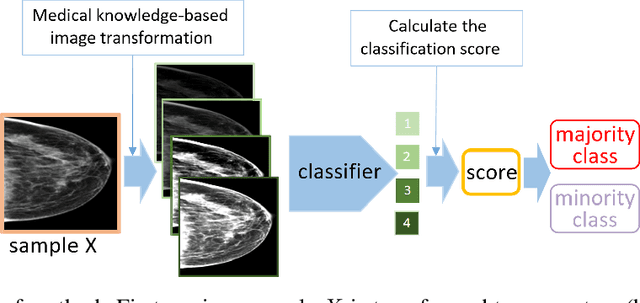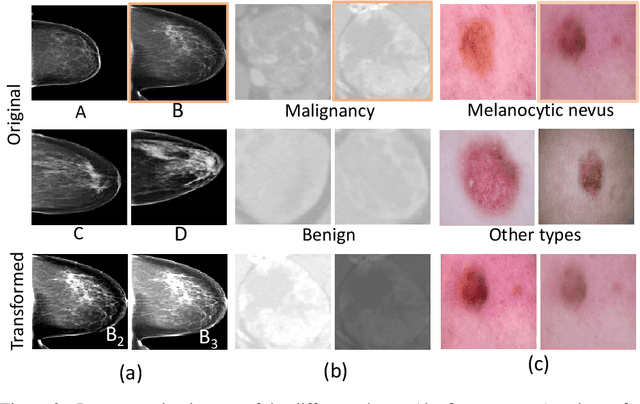Dooman Arefan
Longitudinal Mammogram Exam-based Breast Cancer Diagnosis Models: Vulnerability to Adversarial Attacks
Oct 29, 2024



Abstract:In breast cancer detection and diagnosis, the longitudinal analysis of mammogram images is crucial. Contemporary models excel in detecting temporal imaging feature changes, thus enhancing the learning process over sequential imaging exams. Yet, the resilience of these longitudinal models against adversarial attacks remains underexplored. In this study, we proposed a novel attack method that capitalizes on the feature-level relationship between two sequential mammogram exams of a longitudinal model, guided by both cross-entropy loss and distance metric learning, to achieve significant attack efficacy, as implemented using attack transferring in a black-box attacking manner. We performed experiments on a cohort of 590 breast cancer patients (each has two sequential mammogram exams) in a case-control setting. Results showed that our proposed method surpassed several state-of-the-art adversarial attacks in fooling the diagnosis models to give opposite outputs. Our method remained effective even if the model was trained with the common defending method of adversarial training.
Adversarially Robust Feature Learning for Breast Cancer Diagnosis
Feb 13, 2024Abstract:Adversarial data can lead to malfunction of deep learning applications. It is essential to develop deep learning models that are robust to adversarial data while accurate on standard, clean data. In this study, we proposed a novel adversarially robust feature learning (ARFL) method for a real-world application of breast cancer diagnosis. ARFL facilitates adversarial training using both standard data and adversarial data, where a feature correlation measure is incorporated as an objective function to encourage learning of robust features and restrain spurious features. To show the effects of ARFL in breast cancer diagnosis, we built and evaluated diagnosis models using two independent clinically collected breast imaging datasets, comprising a total of 9,548 mammogram images. We performed extensive experiments showing that our method outperformed several state-of-the-art methods and that our method can enhance safer breast cancer diagnosis against adversarial attacks in clinical settings.
Medical Knowledge-Guided Deep Learning for Imbalanced Medical Image Classification
Nov 20, 2021



Abstract:Deep learning models have gained remarkable performance on a variety of image classification tasks. However, many models suffer from limited performance in clinical or medical settings when data are imbalanced. To address this challenge, we propose a medical-knowledge-guided one-class classification approach that leverages domain-specific knowledge of classification tasks to boost the model's performance. The rationale behind our approach is that some existing prior medical knowledge can be incorporated into data-driven deep learning to facilitate model learning. We design a deep learning-based one-class classification pipeline for imbalanced image classification, and demonstrate in three use cases how we take advantage of medical knowledge of each specific classification task by generating additional middle classes to achieve higher classification performances. We evaluate our approach on three different clinical image classification tasks (a total of 8459 images) and show superior model performance when compared to six state-of-the-art methods. All codes of this work will be publicly available upon acceptance of the paper.
Constrained Deep One-Class Feature Learning For Classifying Imbalanced Medical Images
Nov 20, 2021



Abstract:Medical image data are usually imbalanced across different classes. One-class classification has attracted increasing attention to address the data imbalance problem by distinguishing the samples of the minority class from the majority class. Previous methods generally aim to either learn a new feature space to map training samples together or to fit training samples by autoencoder-like models. These methods mainly focus on capturing either compact or descriptive features, where the information of the samples of a given one class is not sufficiently utilized. In this paper, we propose a novel deep learning-based method to learn compact features by adding constraints on the bottleneck features, and to preserve descriptive features by training an autoencoder at the same time. Through jointly optimizing the constraining loss and the autoencoder's reconstruction loss, our method can learn more relevant features associated with the given class, making the majority and minority samples more distinguishable. Experimental results on three clinical datasets (including the MRI breast images, FFDM breast images and chest X-ray images) obtains state-of-art performance compared to previous methods.
Deep Curriculum Learning in Task Space for Multi-Class Based Mammography Diagnosis
Oct 21, 2021



Abstract:Mammography is used as a standard screening procedure for the potential patients of breast cancer. Over the past decade, it has been shown that deep learning techniques have succeeded in reaching near-human performance in a number of tasks, and its application in mammography is one of the topics that medical researchers most concentrate on. In this work, we propose an end-to-end Curriculum Learning (CL) strategy in task space for classifying the three categories of Full-Field Digital Mammography (FFDM), namely Malignant, Negative, and False recall. Specifically, our method treats this three-class classification as a "harder" task in terms of CL, and create an "easier" sub-task of classifying False recall against the combined group of Negative and Malignant. We introduce a loss scheduler to dynamically weight the contribution of the losses from the two tasks throughout the entire training process. We conduct experiments on an FFDM datasets of 1,709 images using 5-fold cross validation. The results show that our curriculum learning strategy can boost the performance for classifying the three categories of FFDM compared to the baseline strategies for model training.
Knowledge-Guided Multiview Deep Curriculum Learning for Elbow Fracture Classification
Oct 20, 2021



Abstract:Elbow fracture diagnosis often requires patients to take both frontal and lateral views of elbow X-ray radiographs. In this paper, we propose a multiview deep learning method for an elbow fracture subtype classification task. Our strategy leverages transfer learning by first training two single-view models, one for frontal view and the other for lateral view, and then transferring the weights to the corresponding layers in the proposed multiview network architecture. Meanwhile, quantitative medical knowledge was integrated into the training process through a curriculum learning framework, which enables the model to first learn from "easier" samples and then transition to "harder" samples to reach better performance. In addition, our multiview network can work both in a dual-view setting and with a single view as input. We evaluate our method through extensive experiments on a classification task of elbow fracture with a dataset of 1,964 images. Results show that our method outperforms two related methods on bone fracture study in multiple settings, and our technique is able to boost the performance of the compared methods. The code is available at https://github.com/ljaiverson/multiview-curriculum.
* MICCAI 2021 workshop. DOI: https://doi.org/10.1007/978-3-030-87589-3_57. URL: https://link.springer.com/chapter/10.1007/978-3-030-87589-3_57
Medical Knowledge-Guided Deep Curriculum Learning for Elbow Fracture Diagnosis from X-Ray Images
Oct 20, 2021Abstract:Elbow fractures are one of the most common fracture types. Diagnoses on elbow fractures often need the help of radiographic imaging to be read and analyzed by a specialized radiologist with years of training. Thanks to the recent advances of deep learning, a model that can classify and detect different types of bone fractures needs only hours of training and has shown promising results. However, most existing deep learning models are purely data-driven, lacking incorporation of known domain knowledge from human experts. In this work, we propose a novel deep learning method to diagnose elbow fracture from elbow X-ray images by integrating domain-specific medical knowledge into a curriculum learning framework. In our method, the training data are permutated by sampling without replacement at the beginning of each training epoch. The sampling probability of each training sample is guided by a scoring criterion constructed based on clinically known knowledge from human experts, where the scoring indicates the diagnosis difficultness of different elbow fracture subtypes. We also propose an algorithm that updates the sampling probabilities at each epoch, which is applicable to other sampling-based curriculum learning frameworks. We design an experiment with 1865 elbow X-ray images for a fracture/normal binary classification task and compare our proposed method to a baseline method and a previous method using multiple metrics. Our results show that the proposed method achieves the highest classification performance. Also, our proposed probability update algorithm boosts the performance of the previous method.
* SPIE Medical Imaging 2021. DOI: https://doi.org/10.1117/12.2582184. URL: https://www.spiedigitallibrary.org/conference-proceedings-of-spie/11597/1159712/Medical-knowledge-guided-deep-curriculum-learning-for-elbow-fracture-diagnosis/10.1117/12.2582184.short?SSO=1
 Add to Chrome
Add to Chrome Add to Firefox
Add to Firefox Add to Edge
Add to Edge